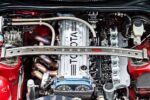Direct injection diesel engines have become a game-changer in the automotive world. These engines are designed to push the envelope of efficiency and performance, making them a popular choice among manufacturers and consumers alike. Unlike traditional diesel engines that mix air and fuel before entering the combustion chamber, direct injection delivers fuel straight into the combustion chamber at high pressure. This results in a more precise fuel-air mixture, leading to better combustion and, ultimately, improved power and fuel economy.
Direct Injection Diesel Engine
The technology behind direct injection diesel engines is not just a gimmick; it’s a serious advancement that has transformed how diesel engines operate. By injecting fuel directly into the combustion chamber, these engines can achieve higher compression ratios and better thermal efficiency. This means more power for less fuel, which is a win-win situation for both performance enthusiasts and eco-conscious drivers.
How It Works
At the heart of a direct injection diesel engine lies a complex system of fuel injectors and electronic controls. The injectors are designed to atomize the fuel into tiny droplets, allowing for a more homogeneous mix with the air. This is crucial because a better mix leads to more complete combustion, which translates to lower emissions and increased power output. Additionally, the electronic control unit (ECU) plays a vital role in timing the injection process to optimize performance under various driving conditions.
Advantages Over Traditional Diesel Engines
One of the standout features of direct injection diesel engines is their ability to deliver torque at lower RPMs. This characteristic makes them excellent for towing and hauling heavy loads, as they provide the necessary power without straining the engine. Furthermore, the improved combustion efficiency means that these engines can achieve better fuel economy compared to their traditional counterparts.
In an age where fuel prices are volatile and environmental regulations are tightening, direct injection diesel engines offer a practical solution. They not only help in reducing fuel costs but also contribute to lower CO2 emissions, making them more compliant with modern standards.
Understanding Direct Injection Diesel Engines
Direct injection diesel engines are reshaping the landscape of automotive engineering. These engines leverage advanced fuel delivery methods to enhance performance, efficiency, and emissions control. Let’s break down the mechanics, advantages, and challenges associated with this technology.
Mechanics of Direct Injection
At the core of a direct injection diesel engine is a sophisticated fuel injection system that operates under high pressure. This system allows for precise control over the fuel-air mixture, which is crucial for optimal combustion. Here’s how it works:
- Fuel Delivery: Fuel is injected directly into the combustion chamber at pressures typically ranging from 1,500 to 2,500 bar.
- Atomization: The injectors atomize the fuel into fine droplets, ensuring a thorough mix with the incoming air.
- Multiple Injection Events: Many direct injection systems utilize multiple injection events per cycle, allowing for better control over combustion timing and efficiency.
Key Components
| Component | Description |
|---|---|
| Fuel Injector | Delivers fuel directly into the combustion chamber at high pressure. |
| High-Pressure Pump | Generates the necessary pressure to inject fuel effectively. |
| Electronic Control Unit (ECU) | Manages the timing and quantity of fuel injection based on various parameters. |
| Combustion Chamber | Where the fuel-air mixture ignites, producing power. |
Advantages of Direct Injection Diesel Engines
Direct injection diesel engines come with a plethora of benefits that make them stand out in the automotive market:
- Enhanced Fuel Efficiency: Thanks to improved combustion efficiency, these engines can achieve better mileage compared to traditional diesel engines.
- Increased Power Output: The ability to inject fuel directly into the combustion chamber allows for higher torque and horsepower, especially at lower RPMs.
- Lower Emissions: More complete combustion results in reduced particulate matter and NOx emissions, making them friendlier to the environment.
- Better Cold Start Performance: Direct injection can improve starting performance in cold conditions, reducing the need for glow plugs.
Challenges and Considerations
While direct injection diesel engines have many advantages, they are not without challenges:
- Injector Wear: The high-pressure operation can lead to increased wear on fuel injectors, necessitating more frequent replacements.
- Carbon Build-Up: Direct injection can lead to carbon deposits on intake valves, as fuel does not wash over them like in port-injected engines.
- Complexity and Cost: The advanced technology and components can make repairs and maintenance more expensive.
Future of Direct Injection Diesel Engines
As manufacturers look to balance performance with environmental regulations, direct injection diesel engines are likely to play a crucial role. Innovations in fuel injection technology, such as piezoelectric injectors, promise even greater efficiency and control. Additionally, the integration of hybrid systems may further enhance the benefits of direct injection diesel engines.
In summary, direct injection diesel engines represent a significant leap forward in automotive technology. They offer a blend of power, efficiency, and lower emissions that traditional diesel engines struggle to match. However, the challenges they present must be addressed to ensure their long-term viability in the automotive landscape.




0 Comments